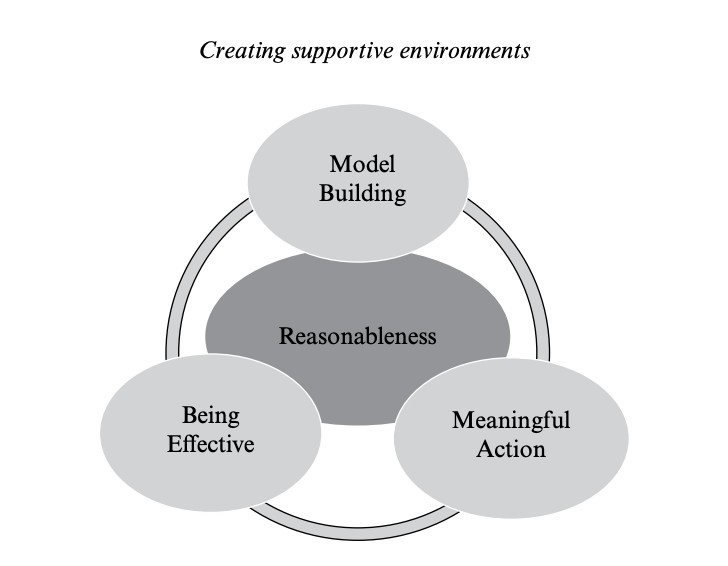
Research & Resources
Go deeper into the science of SEE with our collection of publications and tools. More resources coming soon.
Why is the Golden Rule so hard to follow? How is it relevant to our work and accomplishing our goals?
We dive into these questions as we explore the concept of Meaningful Engagement, which proposes that people need 1) to feel they make a difference, and 2) to foster a sense of belonging through relationships grounded in mutual trust and respect. It's one of the three key tenets of the Supportive Environments for Effectiveness (SEE) framework.
December 10th, 2025.
Overwhelmed by big challenges at your nonprofit? There's a better way to tackle them than starting a new massive overhaul of processes every 6 weeks. reDirect's Small Experiments approach offers manageable changes that help you learn and adapt—low risk, quick to implement, and focused on learning rather than perfection. The process is simple, and replicable. Take a look at this video to learn more about how your organization can benefit from implementing a Small Experiment Mindset™.
October 16th, 2025.
What if the reason you’re stuck isn’t a lack of discipline, but the spaces you live in? Anne Kearney’s experience shows how subtle cues, community habits, and everyday setups can either push you toward your goals or quietly steer you off track. Check out this video to learn about the invisible forces shaping your daily life choices.
August 13th, 2025.
What makes a ‘small experiment’ small? How does it differ from more traditional, research experiments? Rachel Kaplan explores these ideas in her 1996 paper, prepared for EDRA (the Environmental Design Research Association).
January 15, 1996
SEE Coaches Traci Lato-Smith and Kayla Paulson join Nicole R. Smith on her podcast, From the Suggestion Box, to discuss their experience with the SEE framework, volunteer programs, nonprofit operations, and more. Click the link below to listen on Spotify.
May 26, 2023.
Do you ever feel unproductive or burned-out, or struggle to keep up with endless meetings, messages, and emails? The Supportive Environments for Effectiveness (SEE) framework proposes that our environments have a powerful impact on our behavior, and can either hinder or support our success. Rather than focusing on personal shortcomings, SEE helps us identify environmental challenges and design solutions that better support our needs.
April 18, 2023.
How can we overcome the challenges that arise when communicating complex information between experts and non-experts? Watch this video for three lessons on how SEE can help you address these barriers in your own everyday interactions.
April 18, 2023.
Environmental psychologist and reDirect board member Avik Basu shares insights on the SEE framework and Attention Restoration Theory (ART) as a guest speaker on the podcast The Bird Who Made Me Happy. Listen to the full episode (Your Brain on Birdsongs) to learn more about why our attention fatigues, and how nature can help.
December 20, 2022.
How might differences in our mental models influence our ability to communicate with one another? Watch the full video to learn about tips that can help you effectively communicate to reach a point of shared understanding.
December 21, 2022.
A short handout developed by reDirect’s Lisa Bardwell that gives a high-level overview of the SEE framework and questions we can ask ourselves to better leverage it.
November 30th, 2022.
Check out this video to learn more about reDirect's grant programs. Listen as our partners share their SEE journey, the particular challenges and environments they tackled under the program, and what they found to be most impactful about the framework.
October 4, 2022.
Have you ever wondered what actually makes up an 'environment' and why our environments play such an important role in shaping our day-to-day experiences? Check out this video to learn more.
December 10, 2021.
In an increasingly digital world, more and more people are working, learning, or teaching online. Here are three steps you could take to create more supportive online environments, based on the Supportive Environments for Effectiveness (SEE) framework.
December 10, 2021.
A brief presentation on Attention Restoration Theory by William Sullivan and Rachel Kaplan.
June 24, 2021.
Conventional wisdom tells us that we need to work for as long and as hard as possible to do a good job, but research on attention demonstrates that we are actually far less effective when we try to work in long stretches or do too many things at once. This video features changes that you can make to your environment to help reduce fatigue and burnout.
June 10, 2021.
To explore how SEE might apply to a wide variety of contexts, check out our book (available free to read online).
April 15, 2015.
An exploration of how supportive environments might improve well-being, written by Avik Basu, Rachel Kaplan and Stephen Kaplan. This is a chapter from the book Well-Being and Beyond: Broadening the Public and Policy Discourse.
May 28, 2014.
This classic Kaplan & Kaplan paper explores how a psychological perspective on bringing out the best in people could support conservation efforts.
August 22, 2008.
Rachel & Stephen Kaplan describe Supportive Environments for Effectiveness for those new to the topic.
September 2, 2006.
Learn how our collaborators have applied our framework, Supportive Environments for Effectiveness (SEE), on our blog.



















